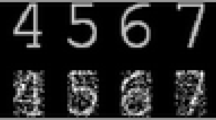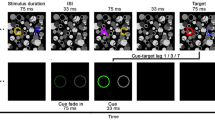Abstract
The focus of attention can be either unitary or divided and can transition from unitary to divided while performing a task. In Experiment 1, we investigated whether alerting hastens the transition from unitary to divided attention. To this end, we employed a dual-RSVP-stream Attentional Blink task (AB; impaired perception of the second of two rapidly sequential targets) with two pairs of letter targets (T1-pair and T2-pair). One component of the AB known as Lag-1 sparing (unimpaired perception of the T2-pair when it is presented directly after the T1-pair) occurs only when the T2-pair falls in an attended location. When the T2-pair falls in an unattended location, the converse pattern occurs (Lag-1 deficit). Accordingly, we used the incidence of Lag-1 sparing/deficit to index whether a location was attended or unattended. We found that presenting a brief brightening flash of the screen (alerting) just before the T1-pair hastened the transition from the initial unitary focus to a divided focus. In Experiment 2, we pitted the hastening account against an alternative hypothesis that the flash triggers phasic activation of the Locus Coeruleus—norepinephrine neuromodulatory system, thus resetting the underlying neural networks that mediate the distribution of attention, triggering a switch from unitary to divided attention. The results of Experiment 2 were incompatible with the hastening account, but consistent with the network-reset account.









Similar content being viewed by others
Availability of data and material
The data will be provided upon reasonable request by email to the first author (LNJ).
Code availability
The code will be provided upon reasonable request by email to the first author (LNJ).
References
Awh, E., & Pashler, H. (2000). Evidence for split attentional foci. Journal of Experimental Psychology: Human Perception and Performance, 26, 834.
Bernstein, I. H., Rose, R., & Ashe, V. M. (1970). Energy integration in intersensory facilitation. Journal of Experimental Psychology, 86, 196.
Bichot, N. R., Cave, K. R., & Pashler, H. (1999). Visual selection mediated by location: Feature-based selection of noncontiguous locations. Perception & Psychophysics, 61, 403–423.
Bouret, S., & Sara, S. J. (2005). Network reset: a simplified overarching theory of locus coeruleus noradrenaline function. Trends in Neurosciences, 28, 574–582.
Brainard, D. H. (1997). The psychophysics toolbox. Spatial Vision, 10, 433–436.
Castiello, U., & Umiltà, C. (1990). Size of the attentional focus and efficiency of processing. Acta Psychologica, 73, 195–209.
Cave, K. R., Bush, W. S., & Taylor, T. G. G. (2010). Split attention as part of a flexible attentional system for complex scenes: Comment on Jans, Peters, and De Weerd (2010). Psychological Review, 117, 685–695.
Chun, M. M., & Potter, M. C. (1995). A two-stage model for multiple target detection in rapid serial visual presentation. Journal of Experimental psychology: Human perception and performance, 21, 109.
Dubois, J., Hamker, F. H., & VanRullen, R. (2009). Attentional selection of noncontiguous locations: The spotlight is only transiently “split.” Journal of Vision, 9, 1–11.
Dux, P. E., & Coltheart, V. (2005). The meaning of the mask matters: Evidence of conceptual nterference in the attentional blink. Psychological Science, 16, 775–779.
Eriksen, C. W., & Yeh, Y. Y. (1985). Allocation of attention in the visual field. Journal of Experimental Psychology: Human Perception and Performance, 11, 583.
Fernandez-Duque, D., & Posner, M. I. (1997). Relating the mechanisms of orienting and alerting. Neuropsychologia, 35, 477–486.
Ghorashi, S. M. S., Jefferies, L. N., Kawahara, J. I., & Watanabe, K. (2008). Does attention accompany the conscious awareness of both location and identity of an object. Psyche, 14, 1–13.
Godijn, R., & Theeuwes, J. (2003). The relationship between exogenous and endogenous saccades and attention. In R. Radach, J. Hyona, & H. Deubel (Eds.), The mind’s eye: cognitive and applied aspects of eye movement research (pp. 3–26). Elsevier.
Jefferies, L. N., & Di Lollo, V. (2009). Linear changes in the spatial extent of the focus of attention across time. Journal of Experimental Psychology: Human Perception and Performance, 35, 1020.
Jefferies, L. N., & Di Lollo, V. (2017). Deployment of spatial attention to a structural framework: exogenous (alerting) and endogenous (goal-directed) factors. Attention, Perception, & Psychophysics, 79, 1933–1944.
Jefferies, L. N., & Di Lollo, V. (2019). Sudden events change old visual objects into new ones: A possible role for phasic activation of Locus Coeruleus. Psychological science, 30, 55–64.
Jefferies, L. N., Enns, J. T., & Di Lollo, V. (2014). The flexible focus: Whether spatial attention is unitary or divided depends on observer goals. Journal of Experimental Psychology: Human Perception and Performance, 40, 465.
Jefferies, L. N., Enns, J. T., & Di Lollo, V. (2019). The exogenous and endogenous control of attentional focusing. Psychological Research Psychologische Forschung, 83, 989–1006.
Jefferies, L. N., Ghorashi, S., Kawahara, J. I., & Di Lollo, V. (2007). Ignorance is bliss: The role of observer expectation in dynamic spatial tuning of the attentional focus. Perception & Psychophysics, 69, 1162–1174.
Jefferies, L. N., & Witt, J. B. (2019). First unitary, then divided: the temporal dynamics of dividing attention. Psychological Research Psychologische Forschung, 83, 1426–1443.
Jolicœur, P., & Dell’Acqua, R. (1998). The demonstration of short-term consolidation. Cognitive Psychology, 36, 138–202.
Kawahara, J. I., & Yamada, Y. (2006). Two noncontiguous locations can be attended concurrently: Evidence from the attentional blink. Psychonomic Bulletin & Review, 13, 594–599.
Kleiner, M., Brainard, D., Pelli, D., Ingling, A., Murray, R., & Broussard, C. (2007). What’s new in psychtoolbox-3. Perception, 36(14), 1–16.
Kramer, A. F., & Hahn, S. (1995). Splitting the beam: Distribution of attention over noncontiguous regions of the visual field. Psychological Science, 6, 381–386.
Lagroix, H. E., Spalek, T. M., & Di Lollo, V. (2015). Does T1 difficulty modulate AB magnitude? It depends on how you measure It. Canadian Journal of Experimental Psychology Revue Canadienne de Psychologie Expertimentale, 69, 367.
McMains, S. A., & Somers, D. C. (2004). Multiple spotlights of attentional selection in human visual cortex. Neuron, 42, 677–686.
McMains, S. A., & Somers, D. C. (2005). Processing efficiency of divided spatial attention mechanisms in human visual cortex. The Journal of Neuroscience, 25, 9444–9448.
Müller, M. M., Malinowski, P., Gruber, T., & Hillyard, S. A. (2003). Sustained division of the attentional spotlight. Nature, 424, 309–312.
Nakayama, K., & Mackeben, M. (1989). Sustained and transient components of focal visual attention. Vision Research, 29, 1631–1647.
Pelli, D. G. (1997). The VideoToolbox software for visual psychophysics: transforming numbers into movies. Spatial Vision, 10, 437–442.
Petersen, S. E., & Posner, M. I. (2012). The attention system of the human brain: 20 years after. Annual review of neuroscience, 35, 73–89.
Raymond, J. E., Shapiro, K. L., & Arnell, K. M. (1992). Temporary suppression of visual processing in an RSVP task: An attentional blink? Journal of Experimental Psychology: Human Perception and Performance, 18, 849.
Shih, S. I. (2000). Recall of two visual targets embedded in RSVP streams of distractors depends on their temporal and spatial relationship. Perception and Psychophysics, 62, 1348–1355.
Usher, M., Cohen, J. D., Servan-Schreiber, D., Rajkowski, J., & Aston-Jones, G. (1999). The role of locus coeruleus in the regulation of cognitive performance. Science, 283, 549–554.
Visser, T. A. (2007). Masking T1 difficulty: processing time and the attenional blink. Journal of Experimental Psychology: Human Perception and Performance, 33, 285.
Visser, T. A., Bischof, W. F., & Di Lollo, V. (1999). Attentional switching in spatial and nonspatial domains: Evidence from the attentional blink. Psychological Bulletin, 125, 458.
Funding
This research was funded by the Australian Government through a Discovery Grant from the Australian Research Council to LNJ and VDL, and by a Discovery Grant from the Natural Sciences and Engineering Council of Canada to VDL.
Author information
Authors and Affiliations
Corresponding author
Additional information
Publisher's Note
Springer Nature remains neutral with regard to jurisdictional claims in published maps and institutional affiliations.
Rights and permissions
About this article
Cite this article
Jefferies, L.N., Ambrose, M. & Di Lollo, V. What factors influence the switch from unitary to divided attention?. Psychological Research 86, 485–496 (2022). https://doi.org/10.1007/s00426-021-01500-x
Received:
Accepted:
Published:
Issue Date:
DOI: https://doi.org/10.1007/s00426-021-01500-x




